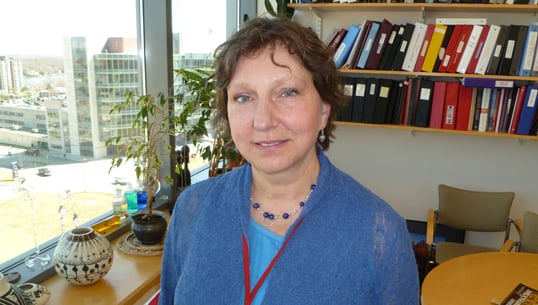
Vivian Budnik, PhD
Professor and Vice Chair of Neurobiology Vivian Budnik, PhD, has received a four-year, $1.3 million EUREKA (Exceptional Unconventional Research Enabling Knowledge Acceleration) grant from the National Institute of Neurological Disorders and Stroke to explore a novel mechanism of communication between the cytoplasm and the nucleus, called nuclear envelope budding, that may lead to a new understanding of various tissue dystrophies and aging disorders.
“This newly discovered mechanism expands our views and opens new questions on how genetic information is integrated with cytoplasmic events,” said Dr. Budnik. “The EUREKA grant does more than allow us to learn about and characterize this important process at the very foundation of cellular biology, but is likely to accelerate our understanding of disorders associated with the nuclear envelope such as Emery-Dreifuss muscular dystrophy, movement disorders such as dystonia, and Herpes virus-type infections.”
The EUREKA grant is part of a program of the National Institutes of Health to fund exceptionally innovative research projects, enabling the establishment of novel concepts and approaches to solve important problems or open new areas for investigation.
Budnik and colleague Melissa J. Moore, PhD, the Eleanor Eustis Farrington Chair in Cancer Research, Howard Hughes Medical Institute Investigator and professor of biochemistry & molecular pharmacology, were the first to observe this unconventional mechanism, which resembles the manner by which Herpes-type viruses escape the nucleus during replication. Appearing to bypass conventional mechanisms of nuclear-cytoplasmic communication, nuclear envelope budding provides an avenue through which large ribonucleoprotein particles assembled in the nucleus can be exported to the cytoplasm. Understanding this mechanism can have implications for diseases such as muscular dystrophies which involve synaptic formation and the nuclear envelope.
With the EUREKA grant, Budnik will work to answer several important questions about the biology behind nuclear envelope budding, such as the exact composition of the nucleoriboprotein granules that use nuclear envelope budding to exit the nucleus; its relation to conventional nuclear export pathways; its evolutionary conservation from insects to humans; and its importance to synaptic assembly in the nervous system.